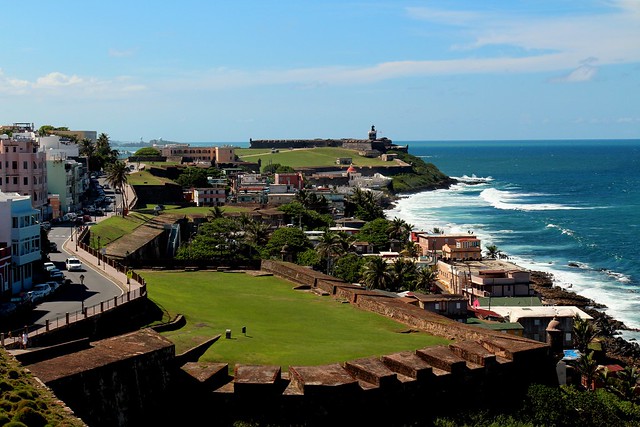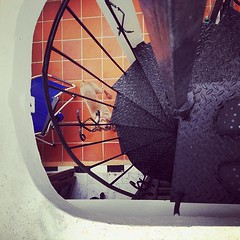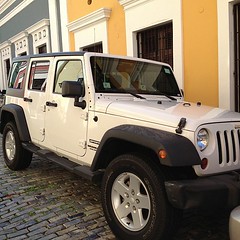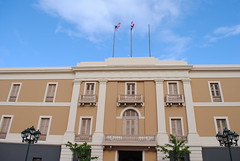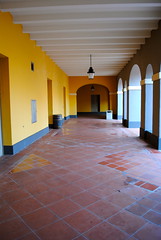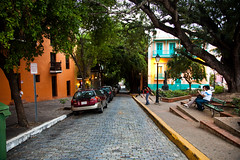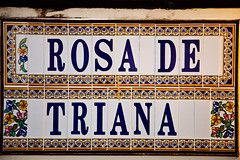Old San Juan, Puerto Rico
Old San Juan (Spanish: Viejo San Juan) is a historic district located at the "northwest triangle" of the islet of San Juan. Its area roughly correlates to the Ballajá, Catedral, Marina, Mercado, San Cristóbal, and San Francisco sub-barrios (sub-districts) of barrio San Juan Antiguo in the municipality of San Juan, Puerto Rico. Old San Juan is the oldest settlement within Puerto Rico and the historic colonial district of the city of San Juan. This historic district is a National Historic Landmark District and is listed on the United States National Register of Historic Places as the Old San Juan Historic District. Several historical buildings and structures, particularly La Fortaleza, the city walls, and El Morro and San Cristóbal castles, have been inscribed in the UNESCO World Heritage Site list since 1983. Historically the mixed use commercial and residential real estate in the main streets like Cristo Street, Fortaleza Street (north) from Tanca Street to the Governor’s Mansion is the most valuable in the area and it has kept its value and increased steadily through several years despite the past economic turmoils.
Location
Old San Juan is located on a small and narrow island which lies along the north coast, about from the east end of Puerto Rico, and is united to the mainland of Puerto Rico by three bridges. It is bounded by the Atlantic Ocean to the north and to the south by San Juan Bay (or "Bahia de San Juan")—which lies between the city and the mainland. On a promontory (Spanish: morro) about high, at the west end of the island and commanding the entrance to the harbor, rise the battlements of Fort San Felipe del Morro, in which there is a lighthouse.
The "Caño de San Antonio" lies to the southeast, where the island of Old San Juan connects to the mainland through Santurce, by three bridges, "Puente Dos Hermanos" (Ashford Avenue), "Puente G. Esteves" (Ponce de León Avenue) and "Puente San Antonio" (Fernández Juncos Avenue).
The city is characterized by its narrow, blue cobblestone streets, and flat-roofed brick and stone buildings, which date back to the 16th and 17th centuries—when Puerto Rico was a Spanish possession. Near Fort San Felipe del Morro, is the Casa Blanca, a palace built on land which belonged to the family of Ponce de León.
History
Origins
In 1508, Juan Ponce de León founded the original settlement, Caparra (named after the Province of Cáceres, Spain, birthplace of the then-governor of Spain's Caribbean territories, Nicolás de Ovando). The ruins of Caparra are known as the Pueblo Viejo sector of Guaynabo, behind the almost land-locked harbor just to the west of the present San Juan metropolitan area. In 1509, the settlement was abandoned and moved to a site which was called at the time "Puerto Rico" (meaning "rich port" or "good port"), a name that evoked that of a similar geographical harbor in the island of Gran Canaria, Canary Islands. In 1521, the name "San Juan" was added, and the newer settlement was given its formal name of "San Juan Bautista de Puerto Rico", following the usual custom of christening the town with both its formal name and the name which Christopher Columbus had originally given the islands, honoring John the Baptist.
Expansion and growth
Constructed in 1521, Casa Blanca served as the first fortification of the settlement and residence of Juan Ponce de León descendants, until the mid-eighteenth century.
La Fortaleza was built between 1533 and 1540, which was followed by the construction of a battery at "the Morro." Plans for the castle portion of San Felipe del Morro were made in 1584. Extensions to the Morro, plus construction of El Cañuelo, and El Boquerón, were made between 1599 and 1609. Circumvallation of the city commenced in 1630 and was concluded by 1641. San Cristobal fort was completed by 1771.
By 1776, the population totaled 6000, half of which were soldiers. The garrison town of San Juan included 250 acres of military installations and 62 acres of public and private use. By 1781, the city's fortifications included 376 cannon. By 1876, 24,000 lived inside the walls of San Juan, encompassing 62 acres, and 926 buildings.
Prior to the 19th century, the area outside the city walls occupying the east side of Old San Juan Island, was almost uninhabited. In 1838 the so-called area of Puerta de Tierra (or "Land Gate") had a population of 168 residents, mainly of African descent. According to a census made in 1846, the population had risen to 223 inhabitants living in 58 houses. On March 3, 1865, the municipal government of San Juan approved a resolution promoting the city expansion across the Puerta de Tierra which included the plan for demolishing the city walls along the eastern side. On May 28, 1897, the wall demolition was officially started after a proclamation was issued by Queen Maria Christina. By the year 1899, the population of Puerta de Tierra had risen to 5,453; while the area comprising the old walled city had a civilian population of roughly 18,103 inhabitants.
Maintaining architectural integrity
During the late 1940s, disrepair in the old city was evident. The local authorities were considering development proposals for renovating the old city and incorporating modern architecture on new constructions. Anthropologist Ricardo Alegría vehemently advised against the idea of razing old colonial buildings in favor of contemporary building designs. He followed the example suggested by his father, a local civic leader who had successfully prevented the demolition of the Capilla del Cristo in favor of a traffic redesign. He advised mayor Rincón de Gautier in having local zoning laws changed to favor remodeling and the incorporation of Spanish colonial motifs in any new construction. This helped preserve the city's architectural profile, and has been a key to San Juan's current status as a tourist destination.
Luis Muñoz Marín, as a senator and later as governor of Puerto Rico, supported and implemented what became known as Operation Bootstrap, which included the development of the tourism industry. In 1948 the government invited one of the organizers of Colonial Williamsburg to lead its tourism development efforts. These efforts were further supported by the 1955 creation of the Institute of Puerto Rican Culture (Instituto de Cultura Puertorriqueña) head by Alegría. He sought legal and administrative changes that would allow for major remodeling efforts to be successful. At the time, most real estate in Old San Juan had devalued under appraised values because the city was perceived as unsafe (particularly because of building disrepair and social ills such as prostitution) and not profitable for business (because of rent control statutes, as well as the reluctance of commercial banks to fund remodeling). Under combined efforts by the institute and the Government Development Bank for Puerto Rico, "model" remodelings were made to show potential property owners how their renewed properties could look. Strict remodeling codes were implemented to prevent new constructions from affecting the common colonial Spanish architectural themes of the old city. As with other Operation Bootstrap projects, mainland corporate investors were lured in with tax breaks and other incentives. When a project proposal suggested that the old Carmelite Convent in San Juan be demolished to erect a new hotel, the Institute had the building declared a historic building, and asked that it be converted to a hotel in a renewed facility. As in other Operation Bootstrap projects, the Woolworth family was invited in 1957 to reconstruct the former convent (which had more recently been a low-rent apartment building and city garage) into the luxury Hotel El Convento. The Bank provided low interest loans to remodelers, and the government gave triple tax exemptions to commercial activities in the old city (they were exempted for a limited time, not only from property taxes and municipal taxes, but from income tax from activities generated in their properties as well). At least one retailer from the shopping district in Charlotte Amalie was given incentives to set up shop in the Calle del Cristo (the city's red light district during the early 1940s) in order to persuade other retailers to follow suit and somehow "clean up" the district. Potential developers were offered sketches of their properties after a remodeling, as to suggest which architectural elements to improve or change. The paradigm to reconstruct and renovate the old city and revitalize it has been followed by other cities in Latin America, particularly Havana, Lima and Cartagena de Indias.
Historic designations
The San Juan National Historic Site was established in 1949 to preserve historic fortifications in Old San Juan. The historic site was added to the National Register of Historic Places in 1966. La Fortaleza along with the San Juan National Historic Site were then declared a World Heritage Site by UNESCO (United Nations Educational, Scientific, and Cultural Organization) in 1983. The casco histórico (old city within the city walls) of San Juan was listed on the National Register of Historic Places in 1972, and was designated a National Historic Landmark in 2013.
Landmarks and attractions
La Fortaleza and the San Juan National Historic District sites
- San Cristóbal Castle (Castillo San Cristóbal), the largest fortification built by the Spanish in the Americas, which provided defense against both land-based and sea attacks by pirates and foreign powers during the colonial period.
- San Felipe del Morro Castle (Castillo San Felipe del Morro, or just El Morro), a 16th century citadel in the northwestern edge of the islet that provided defense against foreign and pirate attacks during the Spanish colonization, also the site of a historic lighthouse.
- Santa Catalina Palace, popularly known as La Fortaleza (Spanish for the fortress), a former fortification and currently the official residence of the governor of Puerto Rico. It is the oldest executive resid…
Hotels Old San Juan, Puerto Rico
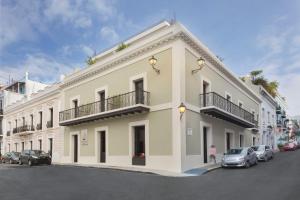 Decanter HotelSan Juan
Decanter HotelSan Juan Villa Herencia HotelSan Juan
Villa Herencia HotelSan Juan Hotel El ConventoSan Juan
Hotel El ConventoSan Juan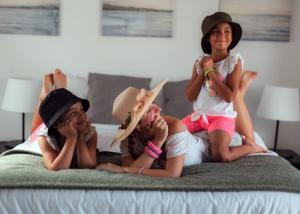 Old San Juan RentalsSan Juan
Old San Juan RentalsSan Juan KASA Roof Top 5 1 Bed 1 Bath for 2 Guests AMAZING Views Old San JuanSan Juan
KASA Roof Top 5 1 Bed 1 Bath for 2 Guests AMAZING Views Old San JuanSan Juan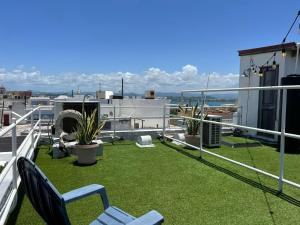 KASA Roof Top 6 1 bed 1 bath for 2 Guests AMAZING Views Old San JuanSan Juan
KASA Roof Top 6 1 bed 1 bath for 2 Guests AMAZING Views Old San JuanSan Juan 2-BR Apt centrally located in OSJ!San Juan
2-BR Apt centrally located in OSJ!San Juan Family Getaway Apt - La Fortaleza Old San Juan - Fort Apt 4San Juan
Family Getaway Apt - La Fortaleza Old San Juan - Fort Apt 4San Juan
Looking for places related to Old San Juan, Puerto Rico?
Those are other destinations to find places related to Old San Juan, Puerto Rico:
- Old San Juan,
- Castillo San Felipe…
- Capitol of
- Castillo de San Cri…
- San Juan Botanical …
- El Yunque National …
- List of lakes in
- Luis Muñoz Marín In…
- University of Puert…
- Convention Center
- José Miguel Agrelot…
- La Fortaleza
- Hiram Bithorn Stadi…
- Roberto Clemente Co…
- Fortín de San Gerón…
- Piñones State Forest
- Academia San Jorge
- Loíza Lake
- El Cañuelo
- Cathedral Dulce Nom…
- Coliseo Rubén Rodrí…
- Arenas Bridge
- Carraízo Dam
- Juan Ramón Loubriel…
